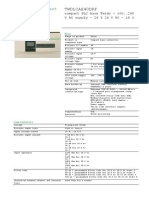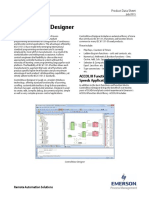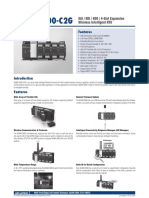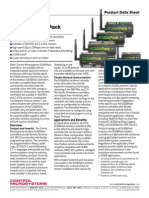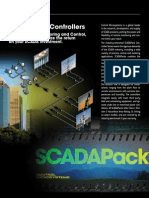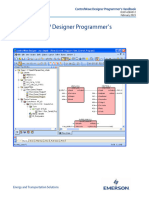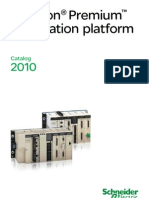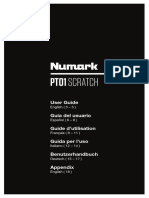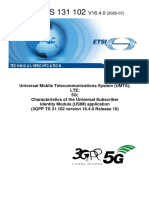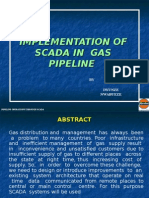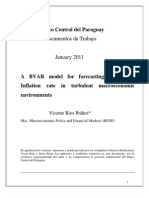Controlwave Express Scada Rtu en 132224
Uploaded by
Luis Miguel EstradaControlwave Express Scada Rtu en 132224
Uploaded by
Luis Miguel EstradaCWExpress Product Data Sheet
D301311X012 March 2023
ControlWave® Express SCADA RTU
Emerson’s ControlWave® Express SCADA RTU provides ▪ 2 selectable Digital inputs/counters
exceptional performance and unique functionality for ▪ 2 selectable Digital/Pulse inputs on CPU
applications requiring low installation cost, very low
▪ 3 optional Analog inputs
power consumption, and space efficiency.
As an integrated RTU in a SCADA system, ControlWave
Express has the unique attributes required for wide
area networks, without sacrificing process control
performance.
▪ Multiple serial communication ports for network,
local and multi-vendor connectivity
▪ Built-in BSAP, Modbus and DNP protocols for
broad network compatibility
▪ Report-By-Exception for communication efficiency
▪ Modbus Store and Forward capability for
geographic flexibility with radio networks
▪ Ultra low power modes for solar applications and
reduced solar panel and battery costs
▪ Wide operating temperature range for remote ▪ 1 optional Analog output
outdoor locations
▪ Wide temperature range (-40 to +70 C)
Compatibility ▪ Class I, Div. 2 hazardous location and CE approval
▪ Open standards for programming, network
Based on years of experience in water, gas and SCADA configuration and communication
related industries, ControlWave Express has the
technology, functional benefits and open architecture Scalability
to excel in many applications.
ControlWave Express can also be combined seamlessly
Water Distribution: Pump, tank, well and reservoir
with other members in the ControlWave family of
control
products. For remote applications requiring more I/O
Wastewater: Lift station and storm water monitoring flexibility, ControlWave Micro provides a modular
and control RTU/PLC expandable up to 14 I/O modules.
Natural Gas: Gas well, storage and plunger lift control For natural gas well site and measurement station
automation, ControlWave single and multi-run flow
Features computers share a common architecture with the
ControlWave family of products and all meet the API
▪ ARM® processor provides exceptional
21.1 requirements for multiple meter runs.
performance and low power consumption
For in-plant control applications, ControlWave and
▪ IEC 61131-3 programming with ACCOL III process
ControlWave Micro are powerful, flexible PLCs.
control function block library
ControlWave offers the greatest local and remote I/O
▪ Optional 100/10 MB Ethernet port
expansion to hundreds of I/O points, up to three
▪ Three serial communication ports Ethernet ports for network segmentation, plus CPU,
▪ Flexible fixed I/O configurations communication and I/O redundancy capability.
▪ 4 Digital inputs The combined benefit of the ControlWave family
▪ 2 Digital outputs
▪ 2 selectable Digital inputs/outputs
Energy and Transportation Solutions
March 2023 CWExpress
products integrates your wide area network with your years of SCADA and plant control experience in
local area network. Emerson’s ACCOL III function block library. ACCOL III
includes over 60 function blocks valuable for use in oil
Open Standards for & gas, water & waste water, and process
measurement & control applications. Further, ACCOL
Programming, Network III is designed to take full advantage of the significant
Configuration and features offered by ControlWave.
Communication Briefly, this library includes function blocks for:
Only ControlWave brings the perfect combination of ▪ Average, Compare, Totalize
industry standards to minimize learning, engineering ▪ Scheduling and Sequencing
and implementation costs. ▪ PID and Lead/Lag
By adhering to such industry standards as Ethernet, ▪ AGA gas flow and liquids calculations
TCP/IP, Microsoft® Windows®, COM/DCOM, FTP, OLE, ▪ File handling
and ActiveX®, ControlWave achieves the highest
degree of openness in control system architecture and Moreover, ControlWave ensures data integrity, in the
bring the optimal process efficiency and productivity event of a communication interruption, by storing
needed to ensure a successful system implementation. critical time-stamped alarm and historical data in the
controller memory. This data is then securely retrieved
ControlWave Designer with when communication is restored.
ACCOL III Specifications
To minimize your engineering and development time, CPU
we have adopted the international standard for PLC
▪ 32-bit ARM processor: 14 and 33 MHz CPUs
programming, IEC 61131-3. ControlWave Designer is a
fully IEC 61131-3 compliant programming environment ▪ Sleep mode for low power applications
for the ControlWave family of products. ControlWave
▪ Real time clock/memory battery backup: 9000
Designer includes all five IEC 61131-3 process
hours
languages for batch, continuous and discrete control:
Function Block Diagram, Structured Text, Sequential ▪ Program execution and data memory: 2 MB
Function Chart, Ladder Logic Diagram, and Instruction battery backed SRAM memory
List.
▪ Data and file storage memory: 8 MB Flash for
ControlWave Designer includes an extensive library of Program source, historical Archive and Audit
more than 200 basic IEC 61131-3 functions and storage
function blocks common to many IEC 61131-3 based
▪ Optional solar power regulator
products. These include:
▪ LED status indicators – six failure status LEDs,
▪ Flip-flops, Counters, and Timers
Watchdog and CPU Idle and communication LEDs
▪ Ladder diagram functions (coils and contacts, etc.)
Communication
▪ Numerical, Arithmetic and Boolean functions
(Sine, Cosine, Add, Sub, Square Root, And, Or, etc.) ▪ Two RS-232 and one selectable RS-232/RS-485
▪ Selection & Comparison (Min, Max, Greater than, serial communication port supporting baud rates
Equal, Less than, etc.) up to 115.2 KB
▪ Type conversions (integer to real, Boolean to ▪ One optional 100/10 Base-T Ethernet port with
Word, etc.) RJ45 connector
One RJ45 connector for interface to
ACCOL III ▪
▪ ControlWave LCD display/keypads
In addition to the basic functions and function blocks,
ControlWave Designer brings the benefit of over 20
2 www.emerson.com/EnergyandTransportation
CWExpress March 2023
Power Input ▪ DIO plus AIO card: 0.021 watt
▪ 5.4 to 16 Vdc power input with 14 MHz CPU - Surge ControlWave Express Process I/O
suppression 16 V transorb
The ControlWave Express I/O module is designed to
▪ 11.4 to 28.0 Vdc power input with 33 MHz CPU -
maximize usability while minimizing installation and
Surge suppression 30 V transorb
maintenance.
▪ Power-fail detection and recovery sequencer
▪ Battery voltage monitor
▪ Reverse voltage protection
Housing
▪ Mounting base plate: 10.75 in. H by 5.5 in. W by
2.0 in. D (273 mm H by 140 mm W by 50 mm D)
▪ Mounting: Flat or edge panel mounting, or
optional DIN mount
The I/O module (bottom card) provides a mix of
Environmental Specifications analog and digital inputs and outputs that are a
▪ Operating Temperature range: perfect fit for small RTU applications.
-40 to 70 C (-40 to 158 F), storage up to 85 C ▪ 2 DI/PI (on CPU)
▪ 1 RTD input on 14 MHz CPU
▪ Relative Humidity: ▪ 4 DI
5-95% non-condensing
▪ 2 DO
▪ Vibration: ▪ 2 selectable DI or DO
1.0g for 10-150 Hz - 0.5g for 150Hz to 2000Hz
▪ 2 selectable DI or HSC
▪ Hazardous Area Approvals: ▪ Optional 3 AI or 3 AI and 1 AO
Non-incendive for operation in Class I, Division 2
Features
CPU RFI
▪ Convenient pluggable local terminations
▪ Immunity: ENV 50140 Radio-frequency
electromagnetic field amplitude modulated EMC ▪ All configuration jumpers and switches accessible
without disassembly of circuit boards
▪ Emissions: EN 55022:1998 Class A ITE emissions
requirements (EU) ▪ Termination points for external loop power supply
▪ ICES-003 Issue 3 Class A Digital Apparatus
Specifications
emissions requirements (Canada)
▪ AS/NZS3548:1995/CISPR Class A ITE emissions All I/O
requirements (Australia)
▪ I/O access: 50 ms with 33 MHz CPU, 250 ms with
I/O RFI Susceptibility 14 MHz CPU
▪ 3V/m – 80 MHz to 1000Mhz (IEC 1000-4-3) ▪ 1 second for 2 DI/PI inputs on CPU board
Power consumption ▪ Surge protection: Meets C37.90-1978
▪ 30 Vdc transorb between signal and ground
▪ 14 MHz CPU: 0.036 watt
▪ Terminations are pluggable and accept a
▪ 33 MHz CPU w/o Ethernet: 0.12 watt
maximum wire size of 16 gauge
▪ 33 MHz CPU with Ethernet: 1.0 watt
▪ DIO card: 0.018 watt
www.emerson.com/EnergyandTransportation 3
March 2023 CWExpress
▪ Power consumption is stated for each I/O module o 4 DI selectable 60 µA for low power
type measured at the input supply and does not applications or 2 mA for in-plant noise
include loop power immunity
o 2 DI/DO selectable 200 µA or 2.2 mA
Pulse/Digital Inputs o DI/HSC selectable 200 µA or 2.2 mA
Inputs located on base CPU board ▪ Input filtering: 15 ms time constant (contact
bounce)
▪ Number of points: up to 2 non-interrupting inputs
▪ Power consumption:
▪ Internally sourced, dry contact single ended
inputs o All 8 inputs ON: 0.005 watt (4 inputs @ 66 µA
and 4 @ 200 µA)
▪ Scan rate: Once per second
o All 8 inputs ON: 0.075 watt (4 inputs @ 2 mA
▪ Input filter: 20 microSec
and 4 @ 2.2 mA)
▪ Voltage Range: Internally sourced dry contact
input - 3.3 Vdc Digital Outputs
▪ On state: >1.6 V, Off state <1.3V ▪ Number of points: 2 dedicated, 2 selectable DO (2
▪ Input current: 200 µA for low power applications DI/DO)
▪ Output type: solid state open drain MOSFET
▪ Power consumption:
▪ Operating voltage range: 10 - 31Vdc
200 µA input, all inputs ON: 0.002 watt
▪ Maximum operating frequency: 20 Hz
Used as Pulse Input:
▪ Current sink capability: 400 mA at 16 V (6 V
▪ Frequency Range: 0-10 kHz system), 400 mA at 30 V (12/24 V system)
▪ Debounce: None ▪ Power consumption: Not applicable to DOs
▪ Accumulator: 16 bit Analog Inputs
RTD Input ▪ Number points: 3 AI optional
▪ Input available on 14 MHz Ultra Low Power CPU ▪ AI Resolution: 14 bit
only ▪ Input Configuration: Externally sourced. Single–
Specifications are for the interface only, not including ended inputs - jumper selectable 4–20 mA or
the RTD probe or wiring ▪ 1–5 Vdc. Terminal block connections provided for
▪ RTD Conversion Accuracy: ± 0.1 C, or ± 0.1% of external source.
reading, whichever is greater ▪ Input Impedance: 1 meg Ω - 15 Vdc;
▪ Ambient temperature effect on RTD 250 Ω - 4-20 mA
measurement: ±0.01 C / C max ▪ Input Filtering: 12 Hz
▪ Long Term Stability at Constant Conditions: ▪ Channel Settling Time: 600 ms to be within 0.01%
±0.25 C / month max of input signal
Digital Inputs ▪ Input accuracy:
▪ Number of points: up to 4 dedicated DI and 4 o 0.1% of span at 25 oC
selectable DI (2 DI/DO, 2 DI/HSC)
o 0.2% of span -40 oC to 70 oC
▪ Non-interrupting inputs
• Power
▪ Internally sourced, dry contact single ended consumption: Not
inputs applicable
▪ Input Voltage Range: Internally sourced dry
Analog Output
contact input - 3.3 Vdc
▪ On state: >1.6 V, Off state <1.3V ▪ Number of Channels: 1 AO optional
▪ Input current: ▪ Output configurations: Selectable externally
sourced 4-20 mA or 1-5 Vdc:
4 www.emerson.com/EnergyandTransportation
CWExpress March 2023
o 250 ohm with 12 V external source OpenBSI supports both serial BSAP protocol and
o 650 ohm with 24 V external source Ethernet Internet Protocol communication to
ControlWave controllers, flow computers and RTUs.
o 1-5 Vdc @ 5mA max., 11 to 30 Vdc external
source OpenBSI Utilities
▪ D/A resolution: 12 bit Above this communication layer is a group of
▪ Accuracy: applications known as the OpenBSI Utilities. These
client utilities communicate through the server to
o 0.1% of span @ 25 C for current output; 0.1%
collect and manage data gathered from the
+ 3% of span @ 25 C for voltage
network, generate files based on collected historical
o 0.3% of span @ -40 to 70 C for current 0.3% + data, collect alarms, and monitor and control
3% of span @ -40 to 70 C for voltage OpenBSI communications.
▪ Power consumption – 1 output: ▪ Communication engine for PC applications
o Analog current output: 0.1 watt ▪ Supports ControlWave serial and IP protocols
o Analog voltage output: 0.1 watt RS 232, Dial-line, cellular, radio, satellite, and
High Speed Counters Ethernet connections
▪ Provides online download & signal variable
▪ Number of points: 2 selectable as HSC or DI
changes
▪ Frequency Range: 0-10 kHz
▪ Allows network configuration through NetView
▪ Input Voltage Range:
▪ PC and Network communication diagnostics
o Internally sourced: 3.3 Vdc
▪ OPC Server for interfacing to most HMI software
o Externally sourced: 3 Vdc to 24 Vdc
▪ Harvester collects historical data on request or
▪ On state: >1.65 V, Off state <1.65 V scheduled basis
▪ Input filter: 20 microSec for 10 kHz 1 ms for 300 Hz NetView is the basic configuration and
LSC application interface for all network operations.
▪ Input current: selectable 200 µA for low power NetView uses a tree structure for network
applications or 2.2 mA for in-plant noise immunity graphical display in the Windows Explorer style.
Network nodes can be added online by simply
▪ Accumulator: 16 bit dragging the node icon into the tree.
▪ Power consumption:
o 200 µA input, all inputs ON: 0.004 watt
o 2.2 mA input, all inputs ON: 0.039 watt
OpenBSI
Simply Creative
Emerson’s OpenBSI (Open Bristol System Inter- face)
is a set of network setup, communication diagnostic,
and data viewing utilities that provide access to
ControlWave controllers, flow computers and RTUs.
Netview - Network configuration
OpenBSI is the only product available in the industry
and application Launchpad
to bring such unique functionality and ease of use to
the network level. At the core is the communication This invokes a configuration Wizard simplifying
interface, written as a Windows communication server network setup. Through the NetView Wizard, the
API through which other client applications necessary network parameters are entered for node
and IP address, alarm and message routing, and
communicate with the Bristol networks.
network communication media. Once configured,
selecting any node allows direct access to the
common OpenBSI utilities to reprogram, download
www.emerson.com/EnergyandTransportation 5
March 2023 CWExpress
a new application to the node, review
communication statistics, view real-time data
through DataViewer, and edit controller/RTU
properties.
Custom built web page interface using a standard web
browser
WebBSI is a powerful and flexible software product
bringing web technology to all ControlWave
automation and SCADA products. WebBSI includes a
Configuration Wizard simplifies Network setup set of ActiveX Controls for reading and writing real-
time and historical data, trending, recipe editing,
Local Configuration Wizard allows local
communication with any attached ControlWave and custom display generation. Through these
controller or RTU to download system flashware controls, you can use the standard Microsoft
upgrades, configure cold download parameters, Internet Explorer web browser to access
and configure IP and soft-switch parameters. ControlWave products through a set of supplied
HTML web pages.
Real-time ActiveX Controls
One of the many benefits OpenBSI brings to you is our
use of open standards such as ActiveX Controls.
ActiveX is a Microsoft standard that allows plug-and-
play with any ActiveX container, using Microsoft
ActiveX container technology such as Visual Basic®,
HTML web pages, and Microsoft Excel®.
The set of available ActiveX Controls provides the
DataView for Real-time data display basic functions necessary to communicate with and
collect data from ControlWave.
DataView is an online utility used to collect and
display several types of process data, including ActiveX Controls
signal values, data array values, signal lists, and
▪ Security – 56-bit encryption - allows the user to
audit trail information.
sign on to the RTU
Operators can alter signal values. Multiple DataView
▪ Signal Value – displays signal values in various
windows may be open simultaneously. formats
▪ Comm Statistics – works with a standard page that
displays the RTU’s communication statistics
▪ Configuration Info – works with a standard page
that displays and allows the user to change
▪ RTU Configuration information
▪ Historical – Collect and view historical archive and
audit files
6 www.emerson.com/EnergyandTransportation
CWExpress March 2023
The IP compliant ControlWave opens the door for OPC Server
owner controlled access via Web Pages. Any generic
With industry demand for open standards,
web page builder can be employed to create user
ControlWave answers the call by embracing
defined pages to access ControlWave. The web
technologies that open the door for maximizing
pages are populated with these pre-configured
your efficiency and productivity. The OPC standard
ActiveX controls.
was developed by the OPC Foundation comprised of
Required Software hardware and software suppliers from the process
control community. OPC allows the engineer to
▪ Microsoft Internet Explorer select best in class hardware and software with
▪ Bristol ActiveX controls confidence in their interoperability. Our OpenBSI
▪ OpenBSI LocalView or NetView OPC Server was among the first to comply with the
OPC Foundation alarm and event server
specification.
Historical Data Collection
▪ OPC Data Access 1.0a & 2.0 compatible
High Historical Data Integrity
▪ WindowsXP
The ControlWave Historical Data Collection sys- tem
▪ Compatible with ControlWave terms
offers exceptional historical data integrity by
providing time-stamped historical data storage in ▪ 32-bit multi-threading, multi-processor design
ControlWave flash memory. The historical data is ▪ Automatic database builder
collected, through OpenBSI on a scheduled or
demand basis and converted to .CSV and ODBC ▪ Integrated real-time data monitor
compliant file formats for use in spreadsheets and ▪ Supports OPC Browse interface
reports. If data is missed due to a communication
▪ Supports both serial comm and IP Ethernet
failure, it is collected when the communication is re-
established and the PC historical database is connections
backfilled with the missing data. This distributed ▪ Supports COM/DCOM & OLE Automation
historical database architecture provides the ▪ Primary and Background polling scheme
greatest data reliability and integrity during
communication or PC failure. ▪ OPC Alarm & Event Server support
Another important historical feature is the Audit
storage and collection system. The Audit Trail is a
ControlWave Open Network Connectivity
file stored in ControlWave flash memory containing By embracing the open system network technologies
significant events and time-stamped alarms. The available through TCP/IP, Ethernet, OPC, and
alarms stored in the Audit system provide a Microsoft DNA, as well as pseudo-standards such as
historical archive in addition to the real-time alarm Modbus and Open Modbus, ControlWave can provide
reporting system. a total Process Automation Management solution for
This file is also collected through OpenBSI and in-plant LAN-based networks and Wide Area Network
presented as a text file in the PC. This functionality (WAN) SCADA systems.
is extremely useful in providing an event trail during
communication or PC downtime or other system With the exceptional connectivity provided by the
problem. ControlWave network, access to real-time data and
operating conditions, historical data, maintenance
and performance data are all available to the global
▪ Archive Collection – collection and storage to disk network. ControlWave provides the needed
of the ControlWave archive data information to the plant floor technician, operator,
▪ Audit Collection - collection and storage to disk of engineer, supervisor and corporate management,
the ControlWave audit data. even external customers.
▪ Exports data files to third party, .CSV, and ODBC Communication Protocols
applications ControlWave supports BSAP (Bristol Standard
▪ DDE compliant for use with other popular Asynchronous Protocol), Modbus, DF1, CIP, DNP3, and
serial ASCII communication protocols as standard
▪ Windows applications
features.
www.emerson.com/EnergyandTransportation 7
March 2023 CWExpress
The DNP3 protocol lends itself to an added layer of ▪ aster and Slave
security through Secure Authentication (SA). SA
▪ Modbus RTU and ASCII
version 5 is available in the ControlWave product
when executed in the application. SAv5 authenticates ▪ Modes 1 - 7, 8, 15 & 16
the devices which significantly improve resistance to ▪ IP modes 51, 52 & 53
the outside influence.
▪ Integer and IEEE 4-byte floating point
These protocols are implemented in flashware so no
additional hardware is required to use any one or a Generic Serial Interface
combination of all protocols. The Generic Serial Interface is a user programmable
Master and Slave protocol used to send and receive
BSAP Protocol
messages typically with third party serial ASCII
BSAP is widely accepted as providing exceptional data devices. This protocol can be used to inter- face with
integrity and greatly simplifies communication such devices and message boards, card readers and
between controllers. BSAP is provided with interfaces many measurement devices.
for Master/Slave, vertical networks, and Client/Server,
horizontal networks. In either case, variable lists are
created in each controller that are easily passed from Multi-user Security Access
server to client or slave to master. Security is an essential element of any open system,
particularly those with Internet access. ControlWave
BSAP meets the definition of an industry-standard, employs a Username/Password access system
open architecture protocol because it conforms to ISO protected by a 56-bit encryption technique through
standards 2629, 1745, and 2111, it is not proprietary in the TCP connection. There can be up to 32 users, who
that Emerson does not charge a license fee and sign-in using their name and password. Both the
makes the protocol and documentation avail- able to name and the password can be up to 16 characters.
anyone.
The security system provides for up to sixty-four
While BSAP is an open protocol, the added access rights to read and write data values and files
functionality of the messages provide much more via FTP, access and configure historical and audit data
capability than is found in other networks. information, edit configuration, run internal
diagnostics, read and reset system status. It further
▪ Global time-synchronization
allows the programming software to read, write and
▪ Time-stamped Alarm reporting download the ControlWave.
▪ Historical archive data transfer
▪ Audit file transfer The Secure Data Advantage
▪ On-line program editing ControlWave sets a new standard for providing
▪ Diagnostics intelligent control at the point where control is
needed. Whether you need control on the plant floor
▪ Communication statistics
or at a remote site in the “middle of nowhere,”
ControlWave is the solution for control,
Modbus Protocol communication, and secure data to help you make the
Modbus is often considered a de-facto standard right operating decisions.
protocol because of its broad usage as either the ControlWave was designed to provide the optimum
primary or a secondary offering in many level of data security using a distributed database
measurement and control related products. Even with architecture. All data including time and date stamped
its common use, Modbus protocol actually has many alarms, alarm limits, and historical data are stored
variations. Consider Modbus RTU and Modbus ASCII, locally in each industrially rugged ControlWave,
Master & Slave, Serial, and TCP/IP Open Modbus. In thereby distributing your data integrity risk. To further
addition there are considerations regarding ensure that the data is always current and historically
supported function codes, floating point values and accurate, the historical data is stored in non-volatile
byte order. Bristol products support the following: flash memory within ControlWave. Historical data is
even maintained during and after program
▪ Modbus serial and TCP/IP Open Modbus
downloading.
▪ (Ethernet)
8 www.emerson.com/EnergyandTransportation
CWExpress March 2023
When historical data is collected from ControlWave, it both networks. TCP/IP allows seamless Ethernet
is converted and appended to .CSV- and/or ODBC- connectivity to both networks as well as the corporate
compliant databases but does not destroy the original Intranet so both ControlWave and Network 3000
historical data stored in ControlWave, thus providing a controllers can reside and communicate on the same
flexible and secure historical data system that is
LAN. Emerson’s Bristol OpenBSI OPC Server facilitates
clearly recognized as a benefit to virtually every
the merging of the two networks for technical,
industrial application.
engineering and operator data access. The data
source, configuration and path are completely
The Bridge Between Systems transparent to the OPC client. Real-time data can also
Continuing our tradition of introducing innovative be passed between the two communication networks
new solutions while maintaining compatibility with making this a total Plant Automation Management
existing systems, Emerson again provides a migration solution.
path for existing customers by bridging the
ControlWave system with Network 3000 systems
already in place. The network bridge is enabled by
employing the open architecture technologies
afforded by TCP/IP and OPC in
Approvals
Miscellaneous Approvals RoHS2 RoHS (2) EU Directive 2011/65/EU: This product may be
considered out-of-scope when used for the intended design
purpose in a Large Scale Fixed Installation (LSFI).
Consult https://www.emerson.com/compliance for up-to-date
product information.
RoHS (China)
www.emerson.com/EnergyandTransportation 9
March 2023 CWExpress
Dimensions: ControlWave
Express SCADA RTU
10 www.emerson.com/EnergyandTransportation
CWExpress March 2023
For customer service and technical support,
visit Emerson.com/SupportNet.
Global Headquarters,
North America, and Latin America:
Emerson Automation Solutions
Energy and Transportation Solutions
6005 Rogerdale Road
Houston, TX 77072 U.S.A.
T +1 281 879 2699 | F +1 281 988 4445
Emerson.com/EnergyandTransportation
United Kingdom:
Emerson Process Management Limited
Regulatory Compliance Department
Company No. 00671801
Meridian East
Leicester LE19 1UX UK
T +44 116 282 2364
[email protected]
Europe:
Emerson S.R.L
Regulatory Compliance Shared Services
Department
Company No. J12/88/2006
Emerson 4 Street
Parcul Industrial Tetarom 11
Romania
T +40 374 132 000
Middle East/Africa: © 2007-2023 Bristol Inc., an affiliate of Emerson Electric Co. All rights reserved.
Emerson Automation Solutions
Energy and Transportation Solutions This publication is for informational purposes only. While every effort has been
Emerson FZE made to ensure accuracy, this publication shall not be read to include any
P.O. Box 17033 warranty or guarantee, express or implied, including as regards the products or
Jebel Ali Free Zone – South 2 services described or their use or applicability. Bristol Inc. (hereinafter “Energy
Dubai U.A.E. and Transportation Solutions” or ETS) reserves the right to modify or improve
T +971 4 8118100 | F +971 4 8865465 the designs or specifications of its products at any time without notice. All sales
Asia-Pacific: are governed by ETS terms and conditions which are available upon request. ETS
Emerson Automation Solutions accepts no responsibility for proper selection, use or maintenance of any
Energy and Transportation Solutions product, which remains solely with the purchaser and/or end-user. Emerson
1 Pandan Crescent Automation Solutions, Emerson, and the Emerson logo are trademarks and
Singapore 128461 service marks of Emerson Electric Co. All other marks are the property of their
T +65 6777 8211| F +65 6777 0947 respective owners.
Energy and Transportation Solutions
You might also like
- Architecting A Website Using The Serverless TechnologyNo ratings yetArchitecting A Website Using The Serverless Technology21 pages
- Payment Gateway Integration Tutorial For Developers - EmerchantpayNo ratings yetPayment Gateway Integration Tutorial For Developers - Emerchantpay31 pages
- Controlwave Micro Product Overview Flier en 132588No ratings yetControlwave Micro Product Overview Flier en 1325882 pages
- Controlwave Micro: Cwmicro Product Data SheetNo ratings yetControlwave Micro: Cwmicro Product Data Sheet11 pages
- PLC Bristol CWM Specification DatasheetNo ratings yetPLC Bristol CWM Specification Datasheet11 pages
- Bristol Controlwave Efm Automation. Measurement. Synergy.: Product OverviewNo ratings yetBristol Controlwave Efm Automation. Measurement. Synergy.: Product Overview2 pages
- Instruction Manual Controlwave Express Ci Controlwave Express en 133070No ratings yetInstruction Manual Controlwave Express Ci Controlwave Express en 13307088 pages
- D5085-Getting Started With ControlWave DesignerNo ratings yetD5085-Getting Started With ControlWave Designer58 pages
- Controlwave Integrated Pump Control (2007) PDFNo ratings yetControlwave Integrated Pump Control (2007) PDF6 pages
- Product Data Sheet Controlwave Designer en 132674 PDFNo ratings yetProduct Data Sheet Controlwave Designer en 132674 PDF9 pages
- Controlwave Control & Communication RedundancyNo ratings yetControlwave Control & Communication Redundancy3 pages
- d301673x012 Modulo de Comunicaciones Serial ControlwaveNo ratings yetd301673x012 Modulo de Comunicaciones Serial Controlwave4 pages
- ISA Certified Automation Professional (CAP) Associate: Certification Exam Prep: 500 Practice Exam Questions and ExplanationsFrom EverandISA Certified Automation Professional (CAP) Associate: Certification Exam Prep: 500 Practice Exam Questions and ExplanationsNo ratings yet
- Controlwave Efm (Electronic Flow Meter) : Instruction ManualNo ratings yetControlwave Efm (Electronic Flow Meter) : Instruction Manual10 pages
- Next-Generation switching OS configuration and management: Troubleshooting NX-OS in Enterprise EnvironmentsFrom EverandNext-Generation switching OS configuration and management: Troubleshooting NX-OS in Enterprise EnvironmentsNo ratings yet
- Adam 3600 C2G - DS (121820) 20201221105950No ratings yetAdam 3600 C2G - DS (121820) 202012211059502 pages
- Adam-3600-C2g - DS (06 26 18) 20180629181140No ratings yetAdam-3600-C2g - DS (06 26 18) 201806291811402 pages
- Expanding Flow Computer Solutions: Demonstrating Technology LeadershipNo ratings yetExpanding Flow Computer Solutions: Demonstrating Technology Leadership2 pages
- Major Solution Components of Industrial Automation: Industrial Automation, #2From EverandMajor Solution Components of Industrial Automation: Industrial Automation, #2No ratings yet
- Solidot Product Catalog PC 20231229-V1.3No ratings yetSolidot Product Catalog PC 20231229-V1.335 pages
- Practical Distributed Control Systems (DCS) For Engineers & Technicians0% (1)Practical Distributed Control Systems (DCS) For Engineers & Technicians6 pages
- Genset Control For Multiple Unit Operation: Easygen-2200/2300/2500No ratings yetGenset Control For Multiple Unit Operation: Easygen-2200/2300/25004 pages
- Twido - Programmable Controller - TWDLCAE40DRFNo ratings yetTwido - Programmable Controller - TWDLCAE40DRF3 pages
- Controllogix Enhanced Redundancy System: User ManualNo ratings yetControllogix Enhanced Redundancy System: User Manual254 pages
- SCADAPack Product Line Comparison BrochureNo ratings yetSCADAPack Product Line Comparison Brochure6 pages
- Controlwave Designer Programmer S Handbook en 178780No ratings yetControlwave Designer Programmer S Handbook en 178780480 pages
- Modicon Premium Automation Platform: CatalogNo ratings yetModicon Premium Automation Platform: Catalog459 pages
- Configuration Manual Digital Viscosity Meter Model 7827 Micro Motion en 63140No ratings yetConfiguration Manual Digital Viscosity Meter Model 7827 Micro Motion en 6314076 pages
- Hfe Sharp Optonica Vz-3000 Cp-V300 ServiceNo ratings yetHfe Sharp Optonica Vz-3000 Cp-V300 Service36 pages
- Data Security System (DSS) /data Synchronization: Improving The Performance and Security of MinesightNo ratings yetData Security System (DSS) /data Synchronization: Improving The Performance and Security of Minesight18 pages
- BUS 210 FALL 2021-2022: Course DescriptionNo ratings yetBUS 210 FALL 2021-2022: Course Description8 pages
- Operator Guide - Slide Mate Laser - A86110100 - EnglishNo ratings yetOperator Guide - Slide Mate Laser - A86110100 - English78 pages
- Michael Arnold, Martin Gibbs, Tamara Kohn, James Meese, Bjorn Nansen - Death and Digital Media-Routledge (2018)No ratings yetMichael Arnold, Martin Gibbs, Tamara Kohn, James Meese, Bjorn Nansen - Death and Digital Media-Routledge (2018)189 pages
- Full The Rough Guide To Bolivia 2 Rough Guide Travel Guides 2nd Edition James Read Ebook All Chapters100% (12)Full The Rough Guide To Bolivia 2 Rough Guide Travel Guides 2nd Edition James Read Ebook All Chapters84 pages
- Graphic Design 2 Working With A Client SampleNo ratings yetGraphic Design 2 Working With A Client Sample47 pages
- Implementation of Scada in Gas PipelineNo ratings yetImplementation of Scada in Gas Pipeline50 pages
- A BVAR Model For Forecasting Paraguay's Inflation Rate in Turbulent Macroeconomic Environments - BCP - PortalGuaraniNo ratings yetA BVAR Model For Forecasting Paraguay's Inflation Rate in Turbulent Macroeconomic Environments - BCP - PortalGuarani26 pages















